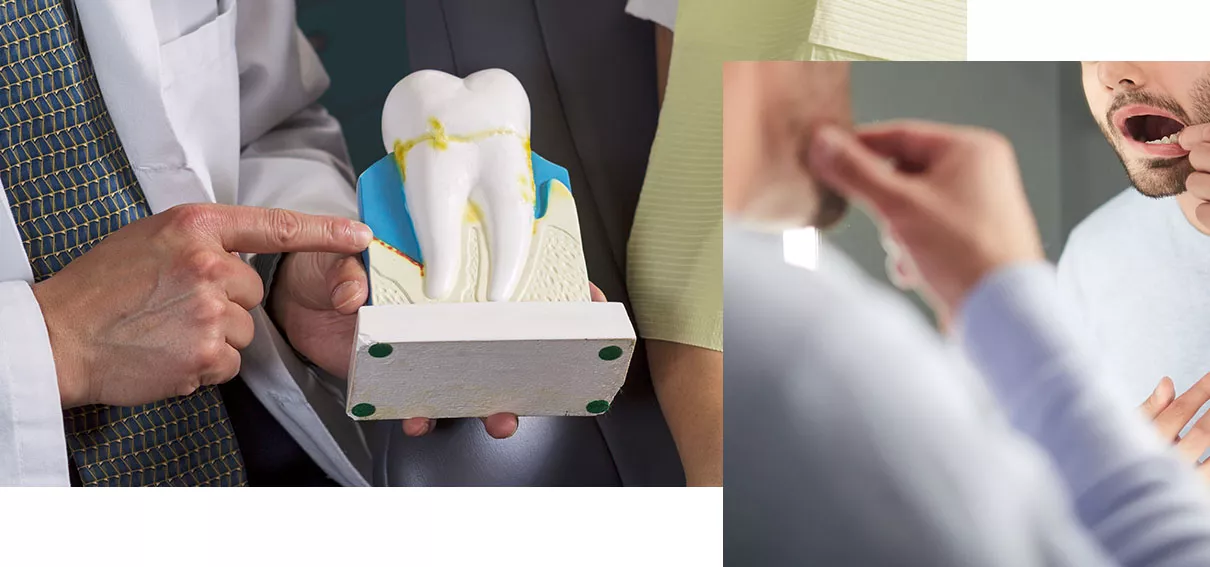Periodontics in North Edmonton
Your gums help protect your teeth from injury and infection. Untreated gum disease can lead to tooth loss and has been linked to heart disease and diabetes. We provide periodontal services to help keep your gums healthy.

Our restorative dental services include:
Tooth Extraction
Damaged teeth sometimes need to be removed to prevent potential infection and damage to other teeth and surrounding tissue. We provide extraction services along with restorations such as dental implants and crowns to replace lost teeth.
Frenectomy
Frenectomy is the removal of connective tissue from areas inside the mouth. This procedure is used to treat conditions such as tongue-tie where the tissue is too tight and causing discomfort.
Scaling and Root Planing
Buildup of plaque and tartar on your teeth can cause inflammation of the gums. This inflammation can make your gums vulnerable to infection and increase the risk of gum disease. Scaling and root planing are treatments to remove buildup and other irritants from the roots of your teeth to prevent inflammation.
Ridge/Socket Preservation
When a tooth is extracted, an empty socket is left in your jaw. If it isn’t preserved, this socket can collapse and cause bone deterioration and displacement of the adjacent teeth. We preserve the socket by filling it with dental material to prevent this from happening.
Ridge Augmentation
The gums and bones in your mouth form a structure dentists call the alveolar ridge. The ridge gives shape to your mouth and supports your teeth. If you’ve lost teeth, the alveolar ridge can deteriorate, which can cause tooth loss and changes in the shape of your mouth. We can rebuild the alveolar ridge with treatments such as bone and gum grafts.
Sinus Augmentation
Dental implants require sufficient bone to hold them in place. Sometimes when an implant is needed in the upper jaw there isn’t enough bone to support it. When this happens, we build up the bone mass using bone grafts before placing the implant.
Bone Grafts
Injury, gum infections, and disease can cause deterioration of the jaw bones. Bone grafts are used to repair this damage. The grafts integrate into the natural bone structure to increase the bone mass and strengthen the area.
Gum Grafting
Damaged gums can be repaired with a gingival graft (gum graft). We treat the damage by grafting gum tissue from another area of the mouth or from a donor, onto the treatment area.
Pocket Depth Reduction
Your gums can sometimes form pockets around the roots of your teeth. These pockets can fill up with food particles and bacteria and become infected. To keep this from happening, we surgically reduce the depth of the pockets, so food doesn’t get trapped in them.
Flap Procedures
Sometimes we need to access areas under the gums or the roots of your teeth. To do this, we make an incision in the gums and open up a small flap. After the treatment is finished, we close the flap with sutures.
Crown Lengthening
Crown lengthening is a treatment to “lengthen” the crown of a tooth for cosmetic reasons or to place a dental crown. The treatment involves removing gum tissue from around the tooth to expose more of the root and make the tooth longer.
Frequently Asked Questions
What’s the link between gum disease and heart disease?
Research shows a link between gum disease and an increased risk of heart disease in patients. It’s believed that untreated gum disease causes the level of inflammation in the body to increase. High levels of inflammation can lead to the development of inflammatory conditions like heart disease.
Is gum disease linked to diabetes?
Current research shows that gum disease and diabetes might be closely linked. Good dental health care and periodontal health may have a positive effect on blood sugar levels, which can help manage diabetic symptoms. Research also shows that people who develop diabetes have a higher risk of developing gum disease.
What is plaque and tartar?
Plaque and tartar are biological substances that can form on the enamel of your teeth. They are both linked to tooth decay and gum disease.
Plaque is a biofilm that sticks to the surface of your teeth. It can host bacteria that cause tooth decay and gum infections. Plaque can be removed by regular brushing and flossing.
Tartar is a hard substance that forms on your teeth along the gumline. Tartar is very hard and can only be removed by a trained hygienist using special tools. If the tartar isn’t removed, it can irritate your gums and make them vulnerable to infection.
